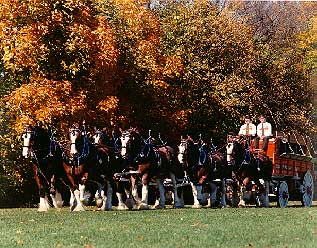

Clydesdale


Introduction: I have seen the Budweiser Clydesdales; they were awesome! If you have any comments or suggestions, please click here.
Names: Clydesdale. Named after the River Clyde (and surrounding valley of the same name) in Scotland. Sometimes referred to simply as the "Clyde."
Origin: The
Clydesdale is hardly more than a century old. (I believe this was written
in the 1970's.) It prospered through its Scottish breeders' strict
attention to quality and pedigree. Modern
Clydesdales date from the middle of the 19th century.
Canada supplied America with its first Clydesdales, but
direct importation from Scotland was going strong by the 1870's. Today
(1974) only the Belgian
is more popular.
Breeding: Said to be descended from native Scottish mares and a Flemish stallion, imported in 1682 by the Duke of Hamilton. Breeding area and studs: All parts of Great Britain and in other countries throughout the world. Clydesdale Horse Society. The Clydesdale breed probably goes back to Flanders stallions, introduced into Scotland (Lanarkshire--then known as Clydesdale) during the seventeenth century.
Description: A heavy horse and a graceful one is the Clydesdale. It moves with the kind of style and action characteristic of the hot-blooded breeds. Conformation in part accounts for this. The Clydesdale looks like a Shire horse but it has a longer neck and a livelier stride.
Action: Regular movements. Long, deliberate walk.
Body: Relatively long neck. Clearly marked withers. Forequarters much higher than hindquarters; long oblique shoulders and short back. Large, broad, well-muscled sloping quarters. Muscular thighs.
Color: The following has been said many times in many ways. This is my (condensed) translation! Almost always bay or brown, and occasionally black; usually with a lot of white on the face and legs, sometimes on the underside as well.
Head: Not an outstandingly noble head. Profile is the "Roman nose" characteristic of draft horses in general.
Hooves: Big and round. ("Big" can be formally translated as "large.")
Legs: Powerful limbs, well-placed forelegs with strong cannons. Legs placed close together, often cow-hocked. Pasterns long and flexible. The Clydesdale is unusually clean-legged for a draft breed, but it is famous for the long, silky feathers that flow about its fetlocks.
Size: Again, I will give my version of many sources. Slightly smaller and lighter than the Shire. Though it is tall--between 16 and 17 hands (usually about 17 hands)--it is the lightest of the drafters. 16.2 to 17.2 hands. Can be up to 18 hands tall.
Temperament: Lively yet good-natured.
Features: Strong and active, but not too heavy. In the show ring the Clydesdale is responsive, high-stepping, even flamboyant due to its long, silky feathers; it moves along smartly without being urged with the whip. For power coupled with elegance, the Clyde's only rival is the Percheron. Very large, strong, heavy horse in great demand. Tough constitution. Noted for strength, weight, utility, dignity and endurance.
Uses: Popular
on farms and for town or country haulage. In America, the Clydesdale
was considered the most desirable breed for city hauling. Anyone who has
ever seen the splendid matched team maintained by the Anheuser-Busch brewing
company can tell why.
Originally used in America to pull heavy carts through city
streets, working teams of Clydesdales can still be seen at agricultural fairs.
Accomplishments:
Curiosities:
Profiles: Dunure Footprint - A Clyde stallion, foaled in 1908; he must be ranked with the great equine progenitors of all time, based on the number and superiority of his offspring.
Conclusion: